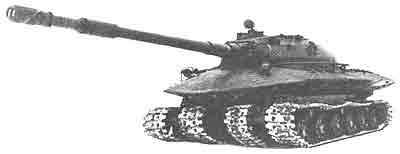Kampfwagen
Junior Member
I think it is pretty basic question, but I will make my question more specific.
For those of you who do not know what an Object 279 is, here is the Down-Low.
In 1957, a prototype Super-Heavy tank was developed by an engineer named L.S Toryanov that was, to say the least, unusual. It is probably the only tank in the world designed specficaly to survive a nuclear exposion.

As you can see, the tanks most unique features were two pairs of two connected treads, and a thin, round saucer-like main chasis. This was a design feature to help protect against HEAT rounds, but most importantly to keep the tank from flipping over from the force of the nuclear explosion. The tank was armed with a 130MM cannon and was loaded with 24 shells and a 14.5MM Anti-Air MG in a classic turret ring. However, how this would not be blasted off with the force of an explosion is beyond me. Maybe they would put it on after the explosion or something. The tank weighed sixty tons, was about seven to eleven meters long, with armor 266-305MM thick. It used a 2DG-8M 1000 Horsepower Engine and had a crew of four.
The project was cancled in late 57 and only one example resides in an armor museum in Russia.
So, here are my questions.
-Is the design fesable?
-What use could the tank have in a post-nuked battlefield?
-Outside of a Nuke situation, would the tank be efective?
-Were any similar notions pursued by NATO?
For those of you who do not know what an Object 279 is, here is the Down-Low.
In 1957, a prototype Super-Heavy tank was developed by an engineer named L.S Toryanov that was, to say the least, unusual. It is probably the only tank in the world designed specficaly to survive a nuclear exposion.

As you can see, the tanks most unique features were two pairs of two connected treads, and a thin, round saucer-like main chasis. This was a design feature to help protect against HEAT rounds, but most importantly to keep the tank from flipping over from the force of the nuclear explosion. The tank was armed with a 130MM cannon and was loaded with 24 shells and a 14.5MM Anti-Air MG in a classic turret ring. However, how this would not be blasted off with the force of an explosion is beyond me. Maybe they would put it on after the explosion or something. The tank weighed sixty tons, was about seven to eleven meters long, with armor 266-305MM thick. It used a 2DG-8M 1000 Horsepower Engine and had a crew of four.
The project was cancled in late 57 and only one example resides in an armor museum in Russia.
So, here are my questions.
-Is the design fesable?
-What use could the tank have in a post-nuked battlefield?
-Outside of a Nuke situation, would the tank be efective?
-Were any similar notions pursued by NATO?
